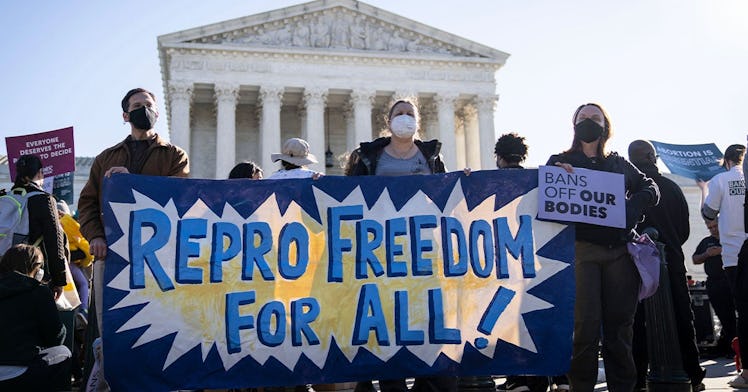The Texas Abortion Law is Back at the Supreme Court — Here’s What’s Next
While the fate of this case is unclear, the justices will take up a more straightforward challenge to abortion rights in a separate case this year.

Today, the Supreme Court is taking up two simultaneous challenges to Texas’s recent law restricting abortions. The court had previously allowed the law, known as SB 8, which allows private citizens to sue anyone who helps a person receive an abortion after six weeks of pregnancy, go into effect in September.
Now the justices have agreed to an uncommonly rapid review of the law — which could impact more than just abortion rights, Politico reports.
The new Texas law allows private citizens to sue any other private citizen who helps someone get an abortion after six weeks of pregnancy. This is before most people know they’re pregnant — and it creates no exceptions for pregnancies resulting from instances of rape or incest, with rare medical exceptions, NPR reports.
The Impact of the Texas Law for Families Has Already Been Seen
After passing the Texas legislature in the spring, the new restrictions first came into effect in early September after the Supreme Court declined to block the law. Five of the court’s more conservative justices voted in favor of allowing the law to proceed, while Chief Justice John Roberts joined with the court’s more left-wing justices in opposition.
Almost immediately, abortions in the Lone Star state almost entirely stopped and legal challenges to the law ramped up. The Biden administration asked a federal district court in Texas to block the law in September — which they did, only to be later reversed by the Fifth Circuit Court of Appeals, notes SCOTUSBlog. The federal government then asked for a block at the Supreme Court again. While the justices denied that request, they did hasten the process and set up the most rapid judicial review since Bush v Gore in 2000, also per SCOTUSBlog.
What’s Going on With Today’s Arguments?
Today’s arguments against the Texas law — brought by both abortion providers and the Biden administration — will test the validity of its unique framework. And that uniqueness could be a sticking point in the case, Politico notes.
Rather than simply restricting or banning abortions as a state government, the Texas law shifts enforcement to private citizens. It was specifically designed this way to get around the usual judicial review process that has stymied many abortion restrictions in recent decades, reports NPR.
Under legal precedent set in the early 20th century, someone can challenge a state government official who’s blocking a constitutional right, notes law professor Mary Ziegler in The Atlantic. “But in Texas,” Ziegler writes, “there arguably is no such officer because only private citizens can sue to enforce the law.”
If that sounds like it could affect far more than just abortion rights to you, you’d be right. The abortion-rights lawyers are arguing that allowing this method of subverting constitutional rights could allow states to create similar laws defying other constitutional rights — including rights beloved by many conservatives, such as the Second Amendment, Politico notes.
Right now, the law remains in effect, and it’s not clear what the justices will decide on this case. But Adam Liptak, a legal journalist at The New York Times, noted in their live coverage of the case that Justices Brett Kavanaugh and Amy Coney Barrett seemed to question the validity of some of this law’s framework. Justice Kavanaugh also specifically brought up the issue of similar potential cases involving guns, the Times notes.
Is Abortion Still Legal?
Abortion is currently legal well beyond the six-week mark in every state but Texas. People who get pregnant have access to medication abortion via mail in every state. It is a very safe medical procedure, and access to it is a vital part of ensuring reproductive rights and health. Most people who get an abortion are parents already and the vast majority of people who complete the procedure say it ended up being the right decision.
The constitutional right to this form of healthcare has been the law for almost 50 years since the Roe v Wade decision in 1973. But now, with a strongly conservative majority on the Supreme Court, many anti-abortion activists are hoping to rein in that right.
What Happens Next?
Even if — a big if — the court rules against this Texas law, they will still hear a more straightforward challenge to the constitutional right to abortion via a Mississippi law later this year. That law is a direct challenge to Roe. The law, which has not yet taken effect in the state of Mississippi, bans abortions after 15 weeks — significantly earlier than the 24 weeks or so used as the estimate of “fetal viability,” the benchmark codified in Planned Parenthood v Casey, reports the Associated Press.
If the Supreme Court lets the Mississippi law be enacted or lets the Texas law stand, then Roe as we know it is effectively over. Some 26 states, per the Guttmacher Institute — will likely rush to create their own abortion bans.
When Justice Sotomayor gave her dissent when Supreme Court Justices allowed the law to stand without ruling on its constitutionality, she stated that SB 8 “has so thoroughly chilled the exercise of the right recognized in Roe as to nearly suspend it within [Texas’s] borders and strain access to [abortion] in other States.” So unless both laws are shut down, the right to an abortion as we know it will change in the United States.